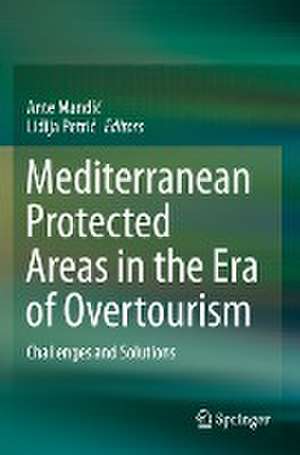Mediterranean Protected Areas in the Era of Overtourism: Challenges and Solutions
Editat de Ante Mandić, Lidija Petrićen Limba Engleză Paperback – 20 apr 2022
This book comprises studies that reflect on various influences of excessive tourism development in protected areas, and solutions designed and initiated to mitigate such challenges. A large proportion of tourism in Mediterranean destinations constitutes nature-based tourism, in particular, tourism in parks and protected areas. As a destination experiences higher intensity and density of tourism, the potential conflict between maintaining a healthy natural environment and economic development also increases. This has urged planners and decision-makers to devise and adopt innovative approaches that seek to strike a balance between tourism development and nature conservation. This book demonstrates the importance of collaboration across and beyond disciplines and of all groups of stakeholders for maximization of societal impacts and tourism-related benefits.
| Toate formatele și edițiile | Preț | Express |
|---|---|---|
| Paperback (1) | 742.04 lei 38-44 zile | |
| Springer International Publishing – 20 apr 2022 | 742.04 lei 38-44 zile | |
| Hardback (1) | 903.93 lei 3-5 săpt. | |
| Springer International Publishing – 20 apr 2021 | 903.93 lei 3-5 săpt. |
Preț: 742.04 lei
Preț vechi: 976.36 lei
-24% Nou
Puncte Express: 1113
Preț estimativ în valută:
142.01€ • 147.71$ • 117.24£
142.01€ • 147.71$ • 117.24£
Carte tipărită la comandă
Livrare economică 08-14 aprilie
Preluare comenzi: 021 569.72.76
Specificații
ISBN-13: 9783030691950
ISBN-10: 3030691950
Pagini: 390
Ilustrații: XII, 390 p. 58 illus., 47 illus. in color.
Dimensiuni: 155 x 235 mm
Ediția:1st ed. 2021
Editura: Springer International Publishing
Colecția Springer
Locul publicării:Cham, Switzerland
ISBN-10: 3030691950
Pagini: 390
Ilustrații: XII, 390 p. 58 illus., 47 illus. in color.
Dimensiuni: 155 x 235 mm
Ediția:1st ed. 2021
Editura: Springer International Publishing
Colecția Springer
Locul publicării:Cham, Switzerland
Cuprins
Chapter 1. Introduction to Mediterranean Protected Areas in the Era of Overtourism.- Part 1: Governance and Management.- Chapter 2. Governance and Management of Protected Natural Areas in the Era of Overtourism.- Chapter 3. Managing Overtourism in Nature-Based Destinations.- Chapter 4. Mitigating the Pressures: The Role of Participatory Planning in Protected Area Management.- Part 2: Local Community and Well-Being.- Chapter 5. Overtourism and the Local Community Well-Being.- Chapter 6. Stakeholder Management and the Imbalance of Power: A Central Mediterranean Perspective on Tourism in Marine Protected Areas.- Chapter 7. Geoeducation and Tourism in Estrela UNESCO Global Geopark (Portugal) and Its Contributions to the Construction of a Sustainable Destination.- Chapter 8. Investigating the Perception and Attitude of Business School Students toward Overtourism at Marseille Calanques National Park.- Chapter 9. Collaborative Destination Management Based on Carrying Capacity Assessment from Resident and Visitor Perspectives: a Case Study of Crikvenica-Vinodol Riviera, Croatia.- Chapter 10. Limits of Acceptable Change (LAC) for Tourism Development in the Historic Centre of Porto (Portugal).- Part 3: Experience Design and Management.- Chapter 11. Integrating Marketing and Management Planning for Outstanding Visitor Experiences in a Turbulent Era: The Case of Plitvice Lakes National Park.- Chapter 12. The Lack of Policy, Planning, and Governance: The Mismanagement of Visitor Pressure in Cumalıkızık, Bursa-a World Heritage Site.- Chapter 13. Aspects of Intensive Short Day Trips on the Remote Pelagic Location: Incorporating Visitor Survey, Radar Tracking and Environmental Risk Analysis in NATURA 2000 Monitoring of the Blue Cave, the Island of Biševo.
Notă biografică
Textul de pe ultima copertă
This book comprises studies that reflect on various influences of excessive tourism development in protected areas, and solutions designed and initiated to mitigate such challenges. A large proportion of tourism in Mediterranean destinations constitutes nature-based tourism, in particular, tourism in parks and protected areas. As a destination experiences higher intensity and density of tourism, the potential conflict between maintaining a healthy natural environment and economic development also increases. This has urged planners and decision-makers to devise and adopt innovative approaches that seek to strike a balance between tourism development and nature conservation. This book demonstrates the importance of collaboration across and beyond disciplines and of all groups of stakeholders for maximization of societal impacts and tourism-related benefits.
Caracteristici
Presents policy and practice solutions to respond to excessive tourism development in protected areas Includes studies demonstrating engagement between researchers, practitioners, and communities Provides a systematic guide to the current state of knowledge in this area Offers examples of collaboration across and beyond disciplines with substantial societal impacts
